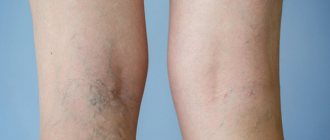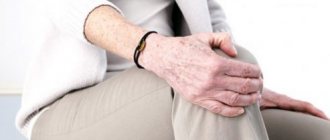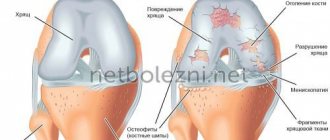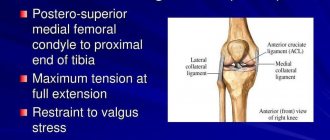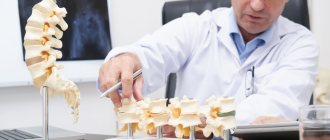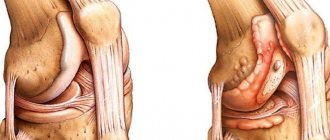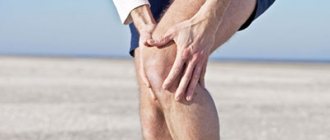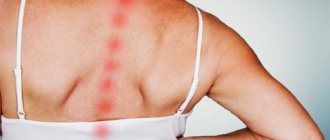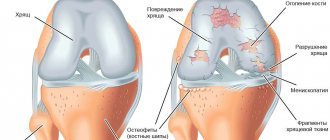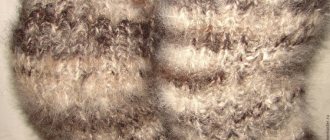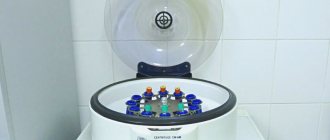Many patients do not know how to relieve pain from arthrosis, so they are forced to constantly experiment with the use of new non-steroidal anti-inflammatory ointments. Over time, they all cease to have an analgesic effect. The next step is the use of pharmacological drugs in tablets and injections. And here a new danger awaits the patient. In search of how to relieve severe pain from arthrosis of the knee joint, they begin to destroy their hematopoietic system, the mucous membranes of the digestive tract, etc.
And the worst thing is that during this entire period of time, intensive destruction of the knee joint occurs. After all, non-steroidal anti-inflammatory drugs do not have any therapeutic effect. They only eliminate an unpleasant symptom – pain – for a while. The moment inevitably comes when knee pain due to arthrosis can only be relieved with the help of intra-articular injection of a corticosteroid drug. Hormonal blockades provide temporary relief and trigger the mechanism of final destruction of bone tissue by provoking the leaching of calcium salts.
Meanwhile, there are very effective and absolutely safe ways to alleviate the patient’s condition. For example, you can quickly relieve pain from arthrosis using some manual therapy techniques. The doctor uses osteopathy and manual therapy to restore the normal position of the heads of the bones in the damaged joint. During treatment, the cartilaginous synovial membrane will be restored. The development of deforming osteoarthritis will be stopped and reversed.
Unfortunately, such assistance can only be provided to patients at stages 1-2 of arthrosis. Therefore, you should not waste precious time experimenting with different compositions of painkillers and anti-inflammatory ointments. They definitely won't help you. You can relieve acute arthrosis pain today. To do this, just sign up for a free initial consultation at our manual therapy clinic. During the examination, the doctor will make a diagnosis and tell you what treatment methods will help restore the health of the damaged joint.
How does gonarthrosis of the knee joint develop?
Gonarthrosis is also called arthrosis of the knee joint.
This disease is popularly known as “salt deposits.” The disease affects the hyaline cartilage, which leads to disruption of the joint. Hyaline cartilage ensures smooth sliding of articular surfaces and reduces friction between them. Cartilage has a multilayer structure. This structure allows it to maintain elasticity and withstand loads. Due to gonarthrosis of the knee joint, changes occur in the cartilage tissue. As a result, the hyaline cartilage becomes thinner, delaminates and cracks.
As gonarthrosis progresses, the cartilage disappears completely, exposing the bone. In response, the bone tissue becomes denser and growths appear on it - osteophytes. They lead to joint deformation and cause pain when putting weight on the knee.
Methods for relieving pain in arthrosis of the knee joint
Relieving pain from arthrosis is possible using a number of methods. First of all, official medicine considers pharmacological methods of influence. Typically, two types of drugs are used:
- non-steroidal anti-inflammatory drugs (Diclofenac, Ortofen, Ketorolac, Baralgin, etc.) - they have the effect of eliminating swelling and relieving the primary inflammatory reaction, creating the effect of visible well-being, while masking further destruction of the cartilage tissue of the joint ;
- corticosteroids (“Prednisolone”, “Dexamethasone”, “Diprospan”, etc.) - have an anti-inflammatory and analgesic effect, but are not therapeutic agents.
In addition, physiotherapy courses may be prescribed to improve local blood circulation and initiate tissue regeneration processes. To improve the condition of the cartilaginous and synovial membranes of the heads of bones, chondroprotectors are prescribed. These are drugs that can restore the structure of the joint. But for them to be effective, they must be administered directly into the joint cavity. Intramuscular injections and oral administration in capsule form do not provide any therapeutic effect.
There are alternative ways to relieve pain from arthrosis of the knee joint, for example, using reflexology and osteopathy. These types of effects make it possible to restore the disturbed energy balance and restore the ability of the tissues of the knee joint to spontaneous recovery. In order to eliminate pain, it is necessary to restore the normal clearance of the joint space between the heads of the bones. This can be done with the help of massage, osteopathy, traction, kinesitherapy.
In the future, to obtain lasting results, it is important to strengthen the muscles surrounding the knee. Therapeutic exercises in combination with massage can increase blood supply to cartilage tissue and enhance the protection of bone heads from destruction.
Symptoms of arthrosis of the knee joint
The main symptom of gonarthrosis is knee pain. She doesn't appear right away. A person experiences knee pain for several months after walking or standing for a long time. The pain appears in the evening and goes away after rest. The disease makes itself felt when walking up stairs; painful sensations appear on the front of the joint and on the side.
With gonarthrosis of the knee joint, a person feels stiffness in the knee in the morning, and the leg has difficulty bending. Movements are accompanied by crunching and crackling sounds in the knee. Usually after half an hour the leg develops and the symptoms disappear. If the signs of the disease are left unattended, it will progress.
As gonarthrosis progresses, the pain becomes stronger. A person quickly gets tired from walking, feels weak in the leg muscles, and feels unsteady. Difficulties arise when bending and straightening the leg. In advanced cases, the patient develops lameness and can only move with the help of strangers or crutches. A person suffers from knee pain at night.
How to reduce and alleviate pain from arthrosis of the knee joint?
Before reducing pain due to arthrosis, it is important to temporarily eliminate physical activity on the injured lower limb. Immobilization of the bone articulation is mandatory. Subsequent physical activity will only further destroy the heads of the bones, which will provoke the transition of the disease to the next stage.
Next, you should consult a doctor who knows how to reduce pain due to arthrosis of the knee joint without the use of dangerous pharmacological drugs. Such a doctor can be found in our manual therapy clinic. After the first session, patients note a significant relief of all symptoms. For complete recovery, you will need to conduct a full course consisting of 8 – 12 sessions. Races are held 1-2 per week. The patient is then given time to recover.
The patient is given practical recommendations on how to relieve arthrosis pain independently at home. To do this, it is not at all necessary to give injections of painkillers. There are a number of massage movements, acupuncture effects and special exercises that relieve pain.
Massage movements must be performed very carefully, since inflamed tissues are easily infected. It is better to contact specialists for these purposes. At home, for temporary pain relief, we can recommend applying compresses with Dimexide. This drug is not a non-steroidal anti-inflammatory drug. It perfectly relieves pain and eliminates inflammation. But, unfortunately, it also does not have any therapeutic effect in terms of restoring pathologically altered joint tissues.
Who is at risk
Most often people suffer from gonarthrosis:
- aged people;
- men and women with leg injury or surgery;
- overweight people - they suffer from gonarthrosis 3 times more often than others;
- professional athletes;
- women during menopause;
- men who work physically hard;
- relatives of patients with gonarthrosis.
Factors that increase the likelihood of this problem also include:
- genetic predisposition, such as Marfan syndrome, in which the joints become “loose”;
- varicose veins, interfering with normal nutrition of the joint;
- various types of arthritis;
- problems with vascular innervation;
- metabolic disorder.
Most often, the problem affects people over 40 years of age, but in young people it can also occur, primarily due to traumatic causes (such as playing sports).
If you are at risk, pay attention to the prevention of gonarthrosis. We will talk about it at the end of the article.
Osteoarthritis of the knee joint
Symptoms and degrees of knee arthrosis | Causes of deforming arthrosis of the knee joint | Treatment of knee arthrosis
Knee arthrosis, gonarthrosis, deforming osteoarthritis of the knee are different names for the same disease. The cartilage becomes thinner, the bones begin to directly touch each other. When moving, friction occurs, which leads to their destruction.
According to WHO statistics, 20% of people in the world have deforming arthrosis of the knee joint.
Sign up
SYMPTOMS AND DEGREES OF KNEE ARTHROSIS
Knee arthrosis is accompanied by severe pain, especially in severe forms. The gait gradually changes, any movement of the knee brings discomfort. Knee arthrosis without treatment leads to complete loss of mobility and disability.
The clinical picture of deforming arthrosis of the knee joint varies depending on the stage of development of the disease:
- Stage 1 knee arthrosis is characterized by mild pain (dull in nature) after heavy loads on the joint (for example, after jogging), slight swelling may occur. Symptoms quickly subside with rest, which often allows you to postpone a visit to the doctor “for later.”
- Stage 2 arthrosis of the knee joint is manifested by severe pain, and a characteristic crunching sound is heard when moving the joint. Symptoms of arthrosis of the 2nd degree of the knee joint occur even with a slight load; after a long period of rest, stiffness in the knee is felt. At this stage, the bones are already deformed, which is noticeable even externally. Most often, patients consult a doctor precisely with such signs.
- Stage 3 deforming knee arthrosis is the most severe, accompanied by constant pain, the joint is severely deformed, and lameness appears. It is extremely difficult to cure grade 3 arthrosis of the knee joint, but it is possible to stop further bone destruction and significantly alleviate the patient’s condition.
CAUSES OF DEFORMATING ARTHROSIS OF THE KNEE JOINT
Primary arthrosis of the knee is diagnosed in the absence of obvious causes of the disease. The appearance of primary arthrosis can be provoked by:
- excess weight (which increases the load on the joint);
- age-related changes (decrease in hormone levels, extinction of metabolic processes, disruption of the endocrine and immune systems);
- osteochondrosis and its complications. Loss of the anatomically correct shape of the spine leads to an increase in the load on the joint and disruption of the blood supply to the joint, and consequently, a lack of nutrition in the knee. Against this background, destructive changes in the joint occur quite rapidly.
Primary arthrosis is characterized by damage to the knee joint on both legs.
There are several obvious reasons for the occurrence of secondary knee deforming arthrosis (which usually affects only one joint)
- various injuries (both external and internal): tendon ruptures, bone fractures, dislocations.
- consequences and complications after knee surgery - other diseases (varicose veins, arthritis, etc.)
Arthritis (that is, an inflammatory process in the joint) is a prerequisite for the appearance of knee arthrosis in almost half of all cases! Chronic inflammation, which remains untreated for a long time, leads to gradual degradation of cartilage tissue. Along the way, other diseases may also occur, for example, synovitis (inflammation of the internal part of the joint, in which fluid accumulates in the knee).
TREATMENT OF KNEE ARTHROSIS IN MC Doctor OST
Any knee pain (especially prolonged pain) is a signal to see a doctor immediately. You can’t trust grandma’s recipes and the advice of friends. This is the path towards complications and the emergence of even bigger problems.
There are no miracle ointments that could restore a damaged joint at home! The depth of influence of any compresses is limited by the skin and the therapeutic effect in this case is minimal.
In addition, before you treat something, you need to know what exactly to treat. Only a qualified doctor can confirm the diagnosis and extent of the lesion after a detailed examination.
“When I tried to raise my left arm, I was seized by wild pain. It turned out that I had arthrosis and ligament rupture. They couldn’t help me at the city hospital, but they could at Doctor Ost, the pain disappeared, and the mobility of my arm returned! » Read full review
Doctors at MC Doctor OST have advanced treatment methods at their disposal. Good results are obtained from complex treatment of arthrosis of the knee joint, using medication, orthopedic and physiotherapeutic treatment (physical education, massage, ultraviolet radiation, magnetic and laser therapy, and other methods). The first task in the treatment of arthrosis of the knee joint is to relieve pain. Thanks to unique hardware techniques (high-intensity laser HILT) and regenerative technologies (intra-articular injection with stromal cells (SVF) and the latest regenerative medicine technique - Plasmogel injection), Dr. Ost MC can instantly relieve even acute joint pain during the first session.
Next, it is important to restore nutrition to the joint tissues, restore mobility to the joint and prevent its further destruction. For this purpose, spinal traction sessions using robotic systems from NASA scientists can be recommended. Timely consultation with a doctor and qualified systemic treatment will allow you to avoid surgery and restore ease of movement!
how much does it cost? Treatment of arthrosis of the knee joint at Doctor Ost is carried out by a rheumatologist and orthopedist. The cost of consulting a specialist is indicated in the “consultative appointment” section of our price list. Follow the promotions, don't miss out on the best price!
Types and causes of gonarthrosis
There are two types of gonarthrosis of the knee joint: primary and secondary.
Primary gonarthrosis most often occurs due to metabolic disorders in the tissues of the joint, intense stress on the knees and natural aging of the body. The disease usually develops after 40 years of age. It appears due to curvature of the legs, hormonal disorders.
Secondary gonarthrosis appears due to injury or fracture of the knee, infectious disease, metabolic disorder, or development of the knee. Secondary gonarthrosis can occur at any age.
There is unilateral and bilateral gonarthrosis. The latter affects the knee joints of both legs. Left-sided gonarthrosis causes pain in the left knee, and right-sided gonarthrosis causes pain in the right.
